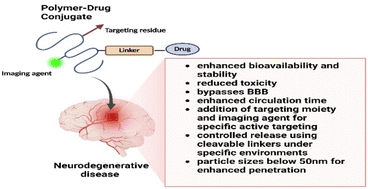Polymer–drug conjugates as nano-sized multi-targeting systems for the treatment of Alzheimer's disease
Abstract
Alzheimer's disease (AD) is a progressive, neurodegenerative condition. There are clear markers for the presence and progression of the disease, including β-amyloid (Aβ) plaques and Tau tangles, with many potential causes debated in the scientific community. Most existing treatments only provide symptomatic solutions. Due to poor aqueous solubility and possibly limited uptake across the blood–brain barrier (BBB), medications targeting the hallmarks of AD are still under study despite enormous efforts. Recently, nanoparticle-based drug delivery systems have demonstrated remarkable promise as precision medicines that may effectively increase bioavailability, permeate the BBB, and improve the targeting ability of a variety of pharmaceuticals. Polymer therapeutics have made tremendous progress in recent years, particularly in cancer treatment. Polymer–drug conjugates (PDCs) typically have a longer half-life, higher stability, and enhanced water solubility. Polymers serve as carriers for the administration of drugs, proteins, targeting moieties, and imaging agents in polymeric and macromolecular prodrugs. Numerous commercially viable PDCs for the treatment of various diseases have already proved their potential. This paper focuses mainly on the rationale for the design, synthesis, and potential use of PDCs as a multi-target treatment for neurodegenerative diseases.

- This article is part of the themed collection: RSC Pharmaceutics 2024 Hot Articles


 Please wait while we load your content...
Please wait while we load your content...